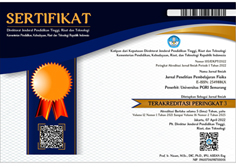Multi-Horizon Short-Term Residential Load Forecasting Using Decomposition-Based Linear Neural Network
DOI:
https://doi.org/10.26877/asset.v7i3.2033Keywords:
DLinear, Time Series Forecasting, Multi-Horizon Forecasting, Energy Management, Smart GridAbstract
Short-Term Load Forecasting is crucial for grid stability and real-time energy management, particularly in residential settings where consumption is highly volatile and influenced by behavioral and external factors. Traditional models struggle to capture complex, non-linear patterns. This study proposes a forecasting framework based on the DLinear model, which decomposes time series data into trend and seasonal components using a simple linear neural network architecture. Designed for multi-horizon forecasting, the model predicts electricity demand across several future time points simultaneously. Experimental results show that DLinear performs best at a 24-hour prediction length, achieving the lowest MSE of 41.58 and MAE of 5.11, indicating improved accuracy with longer horizons. These results confirm DLinear’s robustness and efficiency in modeling dynamic residential electricity consumption patterns.
References
[1] W. Lin, D. Wu, and M. Jenkin, “Electric load forecasting for individual households via spatial-temporal knowledge distillation,” IEEE Trans. Power Syst., 2024, doi: 10.1109/TPWRS.2024.3393926.
[2] S. Gao, Y. Liu, J. Wang, Z. Wang, X. Wenjun, R. Yue, R. Cui, Y. Liu, and X. Fan, “Short-term residential load forecasting via transfer learning and multi-attention fusion for EVs’ coordinated charging,” Int. J. Electr. Power Energy Syst., vol. 164, 2025, Art. no. 110349, doi: 10.1016/j.ijepes.2024.110349.
[3] R. Kaur and D. Gabrijelčič, “Behavior segmentation of electricity consumption patterns: A cluster analytical approach,” Knowl.-Based Syst., vol. 251, 2022, Art. no. 109236, doi: 10.1016/j.knosys.2022.109236.
[4] A. A. Peñaloza, R. C. Leborgne, and A. Balbinot, “Comparative analysis of residential load forecasting with different levels of aggregation,” Eng. Proc., vol. 18, no. 1, 2022, doi: 10.3390/engproc2022018029.
[5] T. Kataray et al., “Integration of smart grid with renewable energy sources: Opportunities and challenges – A comprehensive review,” Elsevier Ltd., Aug. 1, 2023, doi: 10.1016/j.seta.2023.103363.
[6] F. Rodrigues, C. Cardeira, J. M. F. Calado, and R. Melicio, “Short-term load forecasting of electricity demand for the residential sector based on modelling techniques: A systematic review,” Energies, May 1, 2023, doi: 10.3390/en16104098.
[7] J. Li et al., “A novel hybrid short-term load forecasting method of smart grid using MLR and LSTM neural network,” IEEE Trans. Ind. Inform., vol. 17, no. 4, pp. 2443–2452, Apr. 2021, doi: 10.1109/TII.2020.3000184.
[8] H. Tantyoko, D. Nurjanah, and Y. Rusmawati, “Utilizing sequential pattern mining and complex network analysis for enhanced earthquake prediction,” Adv. Sustain. Sci. Eng. Technol., vol. 6, no. 4, 2024, doi: 10.26877/asset.v6i4.1003.
[9] K. S., V. Margaret, and K. Balaraman, “Hybrid short term load forecasting using ARIMA-SVM,” in Proc. IPACT, Apr. 2017, doi: 10.1109/IPACT.2017.8245060.
[10] M. A. Al Amin and Md. A. Hoque, “Comparison of ARIMA and SVM for short-term load forecasting,” in Proc. IEMECONX, 2019, doi: 10.1109/IEMECONX.2019.8877077.
[11] S. K. Agarwal and P. V. Manitha, “Comparative analysis of feedforward neural network and LSTM model for load forecasting,” in Proc. ICSES 2024, pp. 1354–1359, 2024, doi: 10.1109/ICSES63445.2024.10763070.
[12] D. Wu and W. Lin, “Efficient residential electric load forecasting via transfer learning and graph neural networks,” IEEE Trans. Smart Grid, vol. 14, no. 3, pp. 2423–2431, May 2023, doi: 10.1109/TSG.2022.3208211.
[13] Z. Tan, J. Zhang, Y. He, Y. Zhang, G. Xiong, and Y. Liu, “Short-term load forecasting based on integration of SVR and stacking,” IEEE Access, vol. 8, pp. 227719–227728, 2020, doi: 10.1109/ACCESS.2020.3041779.
[14] D. Wu, B. Wang, D. Precup, and B. Boulet, “Multiple kernel learning-based transfer regression for electric load forecasting,” IEEE Trans. Smart Grid, vol. 11, no. 2, pp. 1183–1192, Mar. 2020, doi: 10.1109/TSG.2019.2933413.
[15] K. Chen, K. Chen, Q. Wang, Z. He, J. Hu, and J. He, “Short-term load forecasting with deep residual networks,” IEEE Trans. Smart Grid, vol. 10, no. 4, pp. 3943–3952, Jul. 2019, doi: 10.1109/TSG.2018.2844307.
[16] M. F. Azam and M. S. Younis, “Multi-horizon electricity load and price forecasting using an interpretable multi-head self-attention and EEMD-based framework,” IEEE Access, vol. 9, pp. 85918–85932, 2021, doi: 10.1109/ACCESS.2021.3086039.
[17] M. F. Ainuri, Sarjiya, and I. Ardiyanto, “Short-term load forecasting with long short-term memory: A case study of Java-Bali system,” in Proc. ICITEE 2020, Yogyakarta, Indonesia, Oct. 2020, doi: 10.1109/ICITEE49829.2020.9271763.
[18] X. Liu and W. Wang, “Deep time series forecasting models: A comprehensive survey,” Mathematics, vol. 12, no. 10, 2024, doi: 10.3390/math12101504.
[19] S. F. Stefenon, L. O. Seman, L. S. A. da Silva, V. C. Mariani, and L. dos S. Coelho, “Hypertuned temporal fusion transformer for multi-horizon time series forecasting of dam level in hydroelectric power plants,” Int. J. Electr. Power Energy Syst., vol. 157, 2024, Art. no. 109876, doi: 10.1016/j.ijepes.2024.109876.
[20] D. Ageng, C. Y. Huang, and R. G. Cheng, “A short-term household load forecasting framework using LSTM and data preparation,” IEEE Access, vol. 9, pp. 167911–167919, 2021, doi: 10.1109/ACCESS.2021.3133702.
[21] N. Mohan, K. P. Soman, and S. S. Kumar, “A data-driven strategy for short-term electric load forecasting using dynamic mode decomposition model,” Appl. Energy, vol. 232, pp. 229–244, Dec. 2018, doi: 10.1016/j.apenergy.2018.09.190.
[22] A. Zeng, M. Chen, L. Zhang, and Q. Xu, “Are transformers effective for time series forecasting?,” 2023. [Online]. Available: www.aaai.org
[23] Y. Chen, Y. Zhao, S. Pan, L. Ye, and M. Pei, “Short-term wind power prediction based on DLinear-CrossFormer considering error correction,” in Proc. ACPEE 2024, pp. 2727–2731, 2024, doi: 10.1109/ACPEE60788.2024.10532762.
[24] S. G. Zhao, Y. Cen, and L. C. G. Yongjiang, “Energy demand and renewable energy generation forecasting for optimizing dispatching strategies of virtual power plants using time decomposition-based DLinear,” in Advances in Systems Engineering, H. Selvaraj, D. G., and Z. Chmaj, Eds., Cham: Springer Nature Switzerland, 2023, pp. 3–11.
[25] H. Fan, "Enhancing Long-Term Time Series Forecasting via Hybrid DLinear-PatchTST Ensemble Framework," Applied and Computational Engineering, vol. 142, pp. 145–150, 2025. doi: 10.54254/2755-2721/2025.KL22290.











